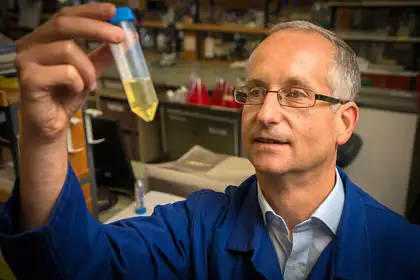
Professor Bernd Rehm.
A Massey professor of microbiology has identified a protein that could help fight serious infections in elderly, cancer, HIV and cystic fibrosis patients.
The research focused on a glue-like substance, called biofilm, which allows bacteria to stick to materials and form a protective layer. Biofilms are found everywhere, like the plaque on your teeth, but while most are harmless, some can be deadly.
The study focused on the bacterium known as Pseudomonas aeruginosa which causes severe wound and lung infections in patients with weak immune systems. The bacteria works by attaching itself to a person’s wound or lung tissue and producing a dense and slimy alginate biofilm, where bacteria can embed themselves and stay protected from the body’s immune system.
Professor Bernd Rehm of Massey’s Institute of Fundamental Sciences, led the study, and says they have found a way to strip the protective layer away so the bacteria can be attacked. “Before this discovery the bacteria was effectively able to take hold of patients with weak immune systems and doctors could do little but sit by and watch it attack the body and spread.
“The bacteria is abundant in our environment and remains relatively harmless to healthy individuals, until carried to the vulnerable, for instance into hospitals, who cannot keep it out. It is so hard to fight, because it is remarkably resistant against a broad range of antibiotics,” says Professor Rehm.
The breakthrough comes with the identification of a protein that may be able to stop the biofilm latching on to tissues and causing an infection, but also may help the body stop the bacteria spreading to other parts of the body and causing a chronic infection.
“The protein influences the chemical composition of the bacteria, and by hijacking that protein we can stop it from taking a hold or spreading,” Professor Rehm says. “The work improves our understanding of bacterial alginate production and provides new knowledge for alginate production and disease control.”
Professor Rehm says the breakthrough may also have other implications for biofilm, which appears naturally in materials such as seaweed. “In the right context, they can be industrially and medically important and can be widely used in food, textile and pharmaceutical industries. The research may aid in improvements to medical products like alginate dressings, which currently use biofilm from the seaweed, but due to seasonal variations in this seaweed the right seaweed is often hard to find.”
The study, Biological function of a polysaccharide degrading enzyme in the periplasm was published in Scientific Reports, a journal from the Nature publishing group. It involved doctoral students Yajie Wang and Mohammad Moradali.